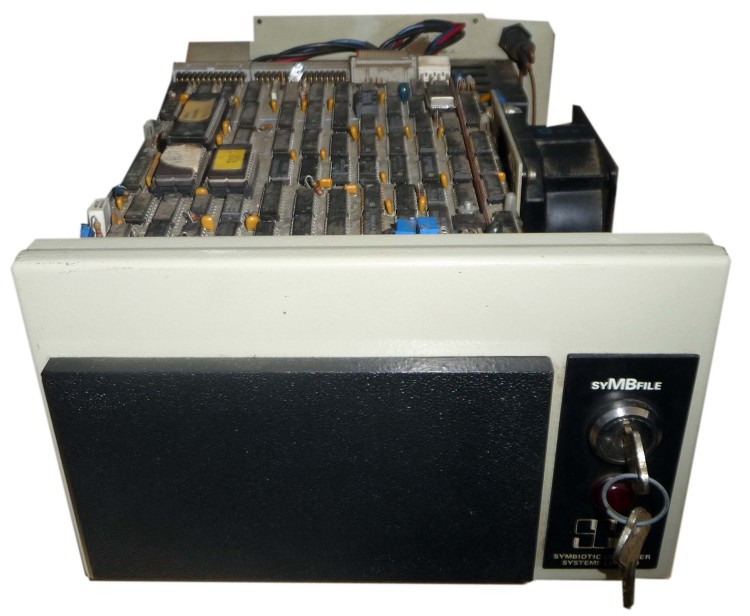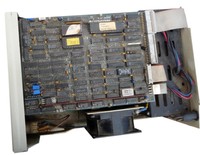SyMBfile Hard Disk for Apple II
| Home > Browse Our Collection > Peripherals > Disk Drives > SyMBfile Hard Disk for Apple II |
|
The SyMBfile Hard Drive was manufactured by Symbiotic Computer Systems Limited (The company was registered in 1982 and appears to have traded up to 1986). This unit was specifically made for an Apple II computer and uses a 5.25-inch Winchester Disk. It was connected to the Apple by a single multiway cable and a buffer/interface card. It supported DOS 3.3, Apple PASCAL and CP/M. It cost £1450 on release in June 1982. The first model (5MB) used the Seagate ST506 and used an onboard Z80A microprocessor). Specification of our unit is unknown but we do know they were also manufactured in 10 and 20MB units. Our unit has a serial number of 25233211 and was kindly donated by Chris Whytehead. Additional information supplied by David Aselford : The initial SyMBfile as stated was based on the 5MB Seagate ST506 (made under licence by Bull in Belfort, France) with a David Junior controller board from the Konan corporation in the US. Following reliability problems with the French made Seagate drive units the Rodime drives from Glenrothes in Scotland were used and capacities of 3, 5, 6, 9, 10 and 20 were available based on their drives. In addition to connecting to an Apple II the units could be connected to a network controller (SyMBnet Controller) which allowed a mix of Apple II (+, e, c, gs) and Macintoshes to be connected to the drive on a network. The network provided a 1Mb connection with a maximum distance of 2Km between computers which was revolutionary for 1984. The networking equipment was all developed in house by SyMBiotic in Croydon. Networks were provided across fibre optic, twisted pair or coax cable as required for the environment. A tape drive backup system (SyMBstore) was also produced which connected to the SyMBnet controller. The tape was a digital cassette the same size as an audio cassette of the time. The tape drive was a joint venture between SyMBiotic and MFE of New Hampshire, USA, the electronics were internally developed by SyMBiotic. When the smaller 3.5-inch drives became available these were used and housed in a smaller physical case the same size as an Apple II floppy disk drive. Macintoshes and Apple IIc computers were connected via an interface box attached to the external floppy disk drive connector, this interface box was also the same size as the Apple II floppy disk drive to allow them to sit on top of the computer alongside the hard disk drive and provide a monitor or Mac support stand. Other machines were connected via an internal interface card. BBC Micro (A and B series) and Thomson CSF networks could also connect to the SyMBnet controller but not mixed with Apple devices on the same network. Network length was limited for these devices as it used the network that came from the relevant manufacturers. All cases were made in Wales, printed circuit boards in Redhill, Surrey power supplies and face plates in South London. Assembly in Croydon, Surrey and Alfreton, Derbyshire. Fibre optic cabling was a joint venture with French cable company Quarz et Silice as no suitable UK fibre cable manufacturer could be found. The cable was Plastic Clad Silica (PCS) so a central uniform density silica core surrounded by two layers of clear plastic then a loose Kevlar and plastic outer jacket, the light was kept in the silica by bouncing off the clear plastic, the second clear plastic bounced back any stray bits and increased efficiency. This design allowed the cable to be installed and easily terminated onsite by nicking the silica then bending it just like cutting a sheet of glass. The kevlar made the cable very strong so could be buried without conduit, it also allowed the cable to be used as a car tow rope on more than one occasion. Your unit is probably a 5MB unit - you can verify this by removing the sliding the drive out the front if it says Seagate or Bull it is 5MB. The Rodime units have a model number starting with R, from memory I think it was... R101 3MB Originally you could also tell by the sticker on the EPROM on the controller board but your sticker is not an original one or the field tech that performed an upgrade did a slack job. The firmware in your EPROM was upgraded to speed up the units by accelerating the heads faster when data is needed from a more remote part of the drive, a somewhat fiddly algorithm allowed the optimum acceleration and deceleration to be calculated to get across the disk faster rather than sequentially going from one track to the next, this was critical when the drives were used on a multi user network. Wherever possible UK suppliers were used for all items so in general an excellent piece of UK engineering which was fairly advanced for it's time. The equipment was sold worldwide and there were SyMBiotic owned or key distributors in UK, US, Netherlands, France, Germany, Italy, Austria, Norway, South Africa, Australia and New Zealand. Two years after the Macintosh version of the SyMBfile shipped Apple introduced it's version of an external hard drive for the Mac using exactly the same technique and hard drive assembly. The technology in SyMBstore was licensed to Teac in 1986. Date : 1982Manufacturer : Symbiotic Physical Description : Hard Drive unit This exhibit has a reference ID of CH19277. Please quote this reference ID in any communication with the Centre for Computing History. |
|











